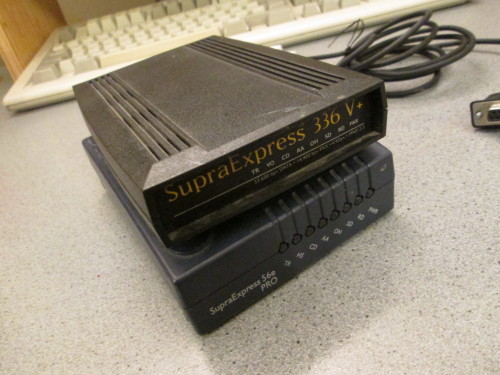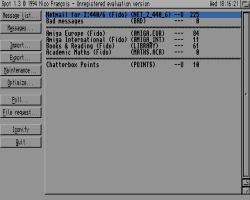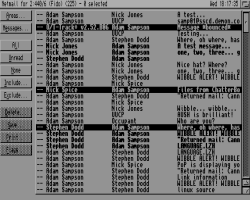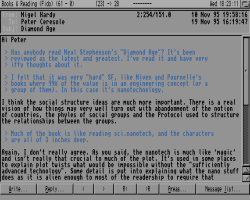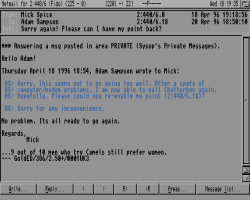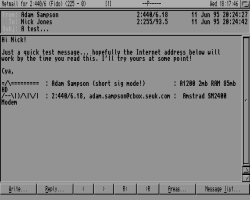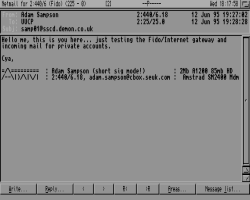The first email service I had at home was through FidoNet: my Amiga 1200 was 2:440/6.18, a point off Mick Spice's Chatterbox BBS in Larkfield.
One of the Amiga backup disks I found contained the data files for my
FidoNet client — a complete archive of my FidoNet email.
However, it was a Maxell MF2DD floppy.
I'd found several of these that took multiple tries to read successfully
with transadf, and this one gave errors no matter what I tried.
Since the errors were being reported in different places on the disk
each time, I decided to try reading the disk several times to see if I
could assemble a complete image...
Reading a recalcitrant floppy
To do this, I used the Disk-Utilities tools.
First, I used diskread to create four raw images of the disk, reading
it twice with the A1200's internal floppy drive (DF0) and twice with
an external one (DF1).
This resulted in 80MB of raw bitstreams:
$ ls -l *.dat
-rwx------ 1 ats ats 20971520 Jan 8 18:45 b27-fidonet-df0a.dat
-rwx------ 1 ats ats 20971520 Jan 8 18:46 b27-fidonet-df0b.dat
-rwx------ 1 ats ats 20971520 Jan 8 18:47 b27-fidonet-df1a.dat
-rwx------ 1 ats ats 20971520 Jan 8 18:48 b27-fidonet-df1b.dat
Next, I used disk-analyse to try to extract the sector data for each
image.
Here's the result for DF0:
$ disk-analyse -v b27-fidonet-df0a.dat b27-fidonet-df0a.eadf
Format "default" -> "amigados"
Found format "amigados"
T111: sectors 1, missing
T113: sectors 9, missing
T125: sectors 5,7, missing
T127: sectors 5, missing
T129: sectors 3, missing
T133: sectors 8, missing
T135: sectors 7,8, missing
T137: sectors 5, missing
T141: sectors 1, missing
T143: sectors 10, missing
T147: sectors 5, missing
T151: sectors 2, missing
T155: sectors 8, missing
T157: sectors 7, missing
T0-159: AmigaDOS
** WARNING: 14 tracks are damaged or unidentified!
And for DF1:
$ disk-analyse -v b27-fidonet-df1a.dat b27-fidonet-df1a.eadf
Format "default" -> "amigados"
Found format "amigados"
T124: sectors 0, missing
T130: sectors 6, missing
T132: sectors 2, missing
T138: sectors 5, missing
T142: sectors 0, missing
T0-159: AmigaDOS
** WARNING: 5 tracks are damaged or unidentified!
So that's exactly what I was after — between the two drives, it
looks like I have a good read for all tracks.
Note that DF0 struggled with one side of the disk (odd-numbered
tracks) and DF1 with the other (even-numbered tracks).
I wonder if trying to read it with the drive upside down might also have
helped?
Next, I needed to merge the two images together.
disk-analyse's output is an EADF file.
The rawadf tool lets you do various
things with EADF files, including replacing tracks in one image with the
equivalent tracks from another.
To make these two tools play nicely together, I had to fix some bugs:
-
disk-analysedidn't clear the EADF track header when it was first created, so it wrote junk into some fields. My patch for this has been merged into Disk-Utilities. -
EADF_MAXTRACKSneeded increasing from 166 to 168 inrawadf. While most Amiga disks only use 160 tracks,disk-analysescans beyond that to detect unusual formats — andrawadfwill complain about the resulting EADF files.
So I used rawadf to combine the two EADF files:
$ rawadf replace b27-fidonet-df1a.eadf b27-fidonet-df0a.eadf \
b27-fidonet-merged.eadf 124 130 132 138 142
I also tried doing the same with the other two images of the disk, to check the result was identical; it was.
Then disk-analyse again to convert EADF back to plain ADF:
$ disk-analyse b27-fidonet-merged.eadf b27-fidonet-merged.adf
T0-159: AmigaDOS
And adfread from Disk-Utilities can extract the filesystem:
$ mkdir t
$ adfread OUT-b27-fidonet-merged.adf t
Backup-27 is an FFS volume
Created: Sat Aug 17 20:57:49 1996
Last altered: Sat Aug 17 21:06:11 1996
t/Backup-27/ Sat Aug 17 21:05:49 1996
t/Backup-27/Mail.Areas.lzx 668021 Sat Aug 17 20:59:30 1996
t/Backup-27/Mail.Others.lzx 163021 Sat Aug 17 21:06:06 1996
Emulating my FidoNet mail reader
Those two archives contain most of an installation of
Spot.
The program executable and manual were on the next backup disk, which
I'd also had trouble reading, missing the last few sectors; however,
after padding the file out with zeroes, I had enough for strings to
pull a version string from the executable:
$VER: Spot 37.4514 (14.8.94)
... and a web search found the GERMAN #463 PD collection in back2roots' extensive archive, which contains exactly the same version of Spot.
I copied these into my FS-UAE system's virtual hard disk, extracted my
backups, and retrieved the missing files from the Spot distribution.
Looking at Spot.Log, the last time I dialled up Chatterbox was on 24th
April 1996.
After setting up the Mail: and NodeList: assigns in user-startup,
Spot started up quite happily, dropping me into an interface that was
oddly familiar given I'd not seen it in 17 years:
Not only did I have all my private mail (netmail), I also had some of the public groups I used to read (echomail).
It turned out that the first couple of messages I sent were through a FidoNet-Internet gateway — one to a friend and one to myself:
I think my email signature these days is a bit less obnoxious...
